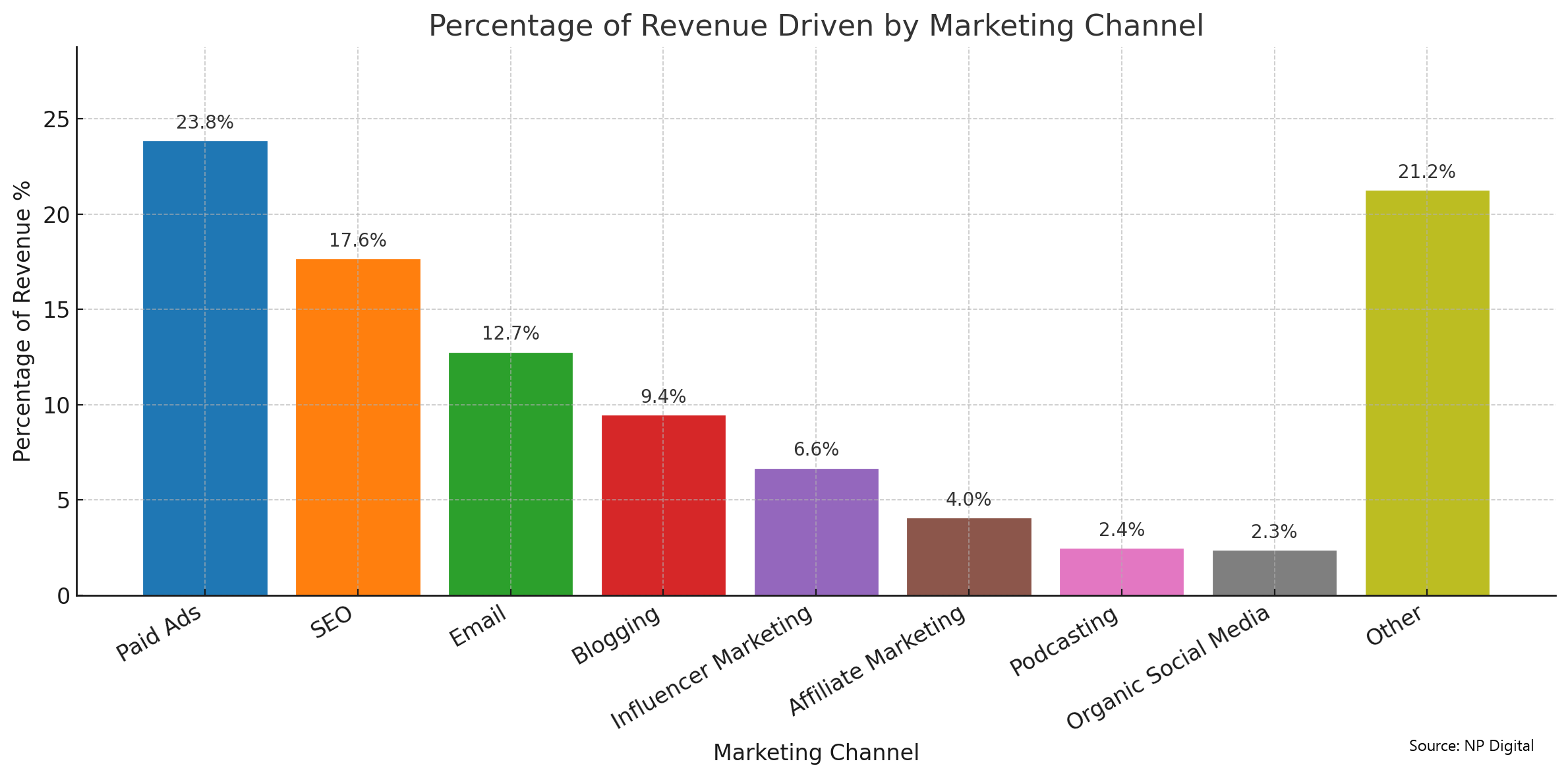Marketing success is rarely driven by a single channel or tactic. Businesses often use a combination of them to attract, convert, and retain customers.
Here's a breakdown of the most common marketing channels, the share of revenue they typically drive, and real-world examples of how companies are using them effectively.

1. Paid Ads (23.8%)
Paid advertising campaigns give businesses immediate visibility and the ability to precisely target their ideal audiences across millions of websites using ad platforms like Google, Meta, YouTube and X.
Examples:
A law firm runs Google PPC Ads targeting the keyword phrase “personal injury attorney near me.”
A fashion retailer launches an Instagram carousel ad promoting a seasonal sale.
A CPA advertises on local TV and radio websites using banner ads during tax season.
2. SEO – Search Engine Optimization (17.6%)
SEO is the art and science of optimizing your website to rank higher in organic (free) search results, helping generate long-term traffic without having to pay for clicks.
Examples:
A local dentist ranks for “teeth whitening San Antonio” with a keyword-optimized service page.
A travel blog targets keywords like “best weekend getaways in Texas” in their blog content.
An e-commerce store builds backlinks to their website through guest posts on other sites.
3. Email Marketing (12.7%)
Email marketing is a direct, personalized way to communicate with leads and customers through newsletters, promotions, and automated email sequences.
Examples:
A course creator sends a welcome email series to new subscribers.
A wellness brand sends out a weekly newsletter with health tips and product discounts.
A real estate agent sets up automated email follow-ups for homebuyer leads.
4. Blogging (9.4%)
Blogging builds authority, supports SEO, and provides consistent content that keeps audiences informed and engaged. Great blog content always provides something of value to its readers.
Examples:
A financial advisor shares weekly insights on retirement and tax planning.
A fitness coach posts exercise routines and healthy recipes.
A pet store offers how-to guides on dog grooming and care tips.
5. Influencer Marketing (6.6%)
Influencer marketing leverages popular online personalities to promote your product or service to their engaged audiences. Local nano influencers with between 1K - 10K followers can be the most cost-effective.
Examples:
A skincare brand sponsors a YouTube beauty guru for a video product demo.
A local restaurant invites Instagram food bloggers to review its menu.
A travel agency partners with Facebook Reel creators to create sponsored vacation vlogs.
6. Affiliate Marketing (4.0%)
Affiliate marketing uses partnerships to drive product sales. Affiliates earn a commission for referring leads to the product owners' sales websites using unique tracking links.
Examples:
A tech blog promotes AI software tools with custom affiliate links.
A digital magazine for seniors promoting natural products for better senior health.
A comparison website reviews various types of home gym equipment with retailer links.
7. Podcasting (2.4%)
Podcasting helps brands build trust, deliver value, and reach loyal listeners through regular audio episodes.
Examples:
A marketing agency hosts a weekly YouTube podcast on digital strategy.
A wellness expert interviews naturopaths and health coaches on Spotify.
A real estate team discusses market trends in their local area using Apple podcast.
8. Organic Social Media (2.3%)
Organic social media uses unpaid content to drive engagement on platforms like Facebook, LinkedIn, TikTok, and Instagram.
Examples:
A bakery posts daily Instagram Stories showcasing fresh menu items.
A business coach shares LinkedIn tips and client success stories.
A boutique hosts a Facebook Live Q&A on seasonal fashion styles.
9. Other (21.2%)
This category includes many offline and hybrid tactics that can still play a big role in generating new revenue for many companies, yet fall outside the boundaries of traditional digital marketing.
Examples:
In-person events and trade shows with post-event follow-up and promotions.
Printed newspaper advertorials and direct response mail with scannable QR codes.
Community sponsorships that build brand awareness and goodwill.
Branded merchandise to give away to current clients and new prospects.
Workshops or seminars showcasing your experience, expertise, authority and trustworthiness (EEAT).
Referral programs that offer discounts or incentives for bringing in new patients.
Which Marketing Channels Are Driving Revenue For You?
Each channel brings something unique to the table. The key to driving revenue in a smart way is not to spread yourself too thinly, but by focusing instead on the 2, 3 or even 4 marketing tactics that best align with your audience, offer, and brand voice. Test, measure, and then commit to using those channels that work best for you.

 Add Row
Add Row  Add
Add 




Write A Comment